The Iconic American Infantry Fighting Vehicle
The Bradley is a pure product of the renewal of the US Army after the end of the Vietnam war, part of a large program that also comprised the M1 Abrams. The M2 Bradley (and the derivated M3 recce version), has been proven in combat in the Middle East, from the 1991 Gulf War to the invasion of Iraq and aftermath, as well as the intervention in Afghanistan.It is still produced today under modernized packages by BAE Systems Land & Armaments (former United Defense) and so far 4,641 has been cranked up while the latest version, the M2A3 Bradley II (2000) while other machines are being restored and upgraded to the ECP1 (2015) and ECP2 upgrade package (2018). So far, like the Abrams, no replacement is sought for.
Development - early phase (1970s)

Artist views of the MICV 65
The M2 Bradley is notorious for its long, tumultuous, and overall costly development (see "pentagon wars"), a surprising long answer to the 1960s Soviet BMP-1 which left NATO baffled for some time. Total cost of the program is now estimated over $5,664,100,000 () while the average unit costs is about $3,166,000. So far, only Saudi Arabian operates it outside the US Army. But it changed recently, when Ukraine acquired 180+ Bradley M2A2s.
Early US IFV development

1967 Mockup
The very root of the M2 Bradley could be found in the M113/M60 development, the M113 infantry carrier being just fast enough to cooperate with the M60 in combined mechanized operation. The new MBT-70 and XM-1 development in the 1970s that will led to the Abrams was a much faster tank that the M113 could not follow. That imposed a choice, either modernize the M113 (making it faster and better armed), or develop a brand new vehicle altogether.

In the background there was also the imperative to find a fitting response to the Soviet BMP-1, a proper infantry fighting vehicle: Retaining troop carrying capabilities while having a firepower sufficient to deal with any modern threat on the battlefield, including all armoured vehicles, and helicopters. The Bradley program came out when light tank were considered obsolete: The M551 Sheridan would remain the last one, an impossible compromise.
As a result, the Bradley benefited from a thirty-years long development of the IFV concept, which started in 1963 with the MICV-65 and later 70, the M114, XM701, XM723/765 MICV, or the ill-fated and short-lived XM800 Armored Reconnaissance Scout Vehicle.
One can also cite General DePuy at TRADOC and General Starry at the U.S. Army Armor Center and School at Fort Knox, Kentucky for the impetus for the final development of the Bradley (former MICV, for Mechanised Infantry Combat Vehicle), although many work groups were created, spanning 1968 to 1976.
M113 derivatives and early IFVs
M114A2 IFV
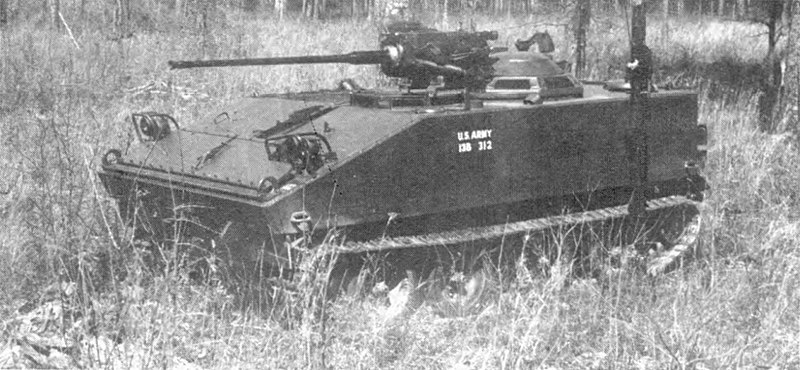
Perhaps the M114 is the earliest example in the development tree. It was an attempt by Cadillac to rival FMC's M113 with a lighter, sleeker design drawing the first lessons from the Vietnam war. Amphibious, it was given on its A1 version a gunner's cupola for the cal.50, but more interesting, the M114A2 (1969), initially called M114A1E1 mounted a Hispano-Suiza HS.820 20 mm gun (M139 in U.S. service) coupled with a hydraulically powered cupola. This was an early IFV by all but name, but the whole project was terminated in 1973 as the vehicle was unreliable and underpowered. It was declared a failure by Gen. Creighton Abrams which asked it to be retired from all frontline units.
MICV65: XM701/734/765
The United States Army Infantry School, Fort Benning, explored alternatives early on, toying with the M113 to offer more firepower. They changed the crew arrangement (benches in the middle, back-to-back, facing out for pistol ports) for mounted fighting infantry. This led to the XM734, which had in addition a centrally mounted one-man enclosed gun cupola, and pintles for extra MGs mounts.Issues with the program (leading to cancellation) would be the intolerable heat inside the cabin and rotting rubber firing port seals. The Army created in 1963 the official MICV-65 program and the XM701 was one of such official prototypes, designed by Pacific Car and Foundry. It was based around a pool of components shared with the M109 and M110 self-propelled guns. Both its size, weight, slow speed and lack of strategic mobility (not air-transportable), led to its demise in 1966.
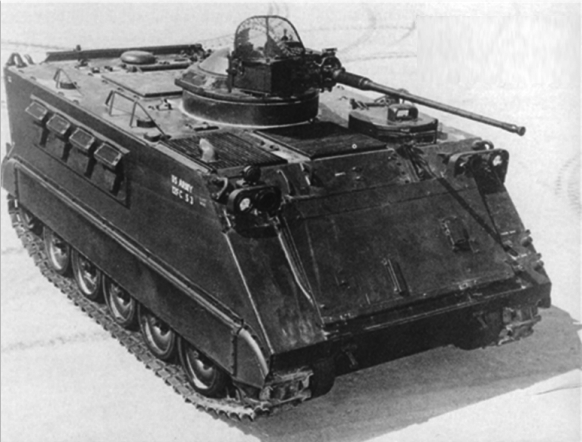
XM734 (cc)
FMC's XM765 and 734 were closely related, and both based on the M113. These private ventures resulted in the Armored Infantry Fighting Vehicle (AIFV), which Variants called YPR-765 are were developed for export and are in service with with the Netherlands, Philippines, Belgium, and Turkey, which all already used the M113 and appreciated the commonality.
MICV65: XM765

The FMC Corporation, was a losing bidder in the MICV-65 program: Indeed by 1967, it was awarded a contract for two candidate infantry fighting vehicles not adopted by the Army. However FMC went on the development as a private venture, creating ultimately the Armored Infantry Fighting Vehicle (AIFV), later designated XM765. It was adopted for local production under licence in the Netherlands as YPR-765, but also the Philippines, Belgium, Turkey. The Dutch YPR–765 was a license-built version of the AIFV FMC.
MICV70: XM723

In August 1968, Army Chief of Staff General William C. Westmoreland set up the Study Group called Casey Board to examine the MICV concept and make weight/cost reduction recommendations.As the Vietnam war was still going on, and the XM765 was rejected, the Army contracted FMC for a better vehicle and in April 1972, its new RFP called for the MICV70, with six companies answering, and three selected.
FMC's XM723 Mechanized Infantry Combat Vehicle

MICV 70 mockup
Food and Machinery Corp prototype development can be traced back to the rejection of the XM765 AIFV as a new contract was awarded to FMC for a frank departure from the M113. Specs requirements for a new Mechanized Infantry Combat Vehicle (MICV) were issued in April 1972, submitted to six companies, of which three were selected, the Chrysler Corporation, FMC, and Pacific Car and Foundry.
They had to issue cost estimates and design prototypes, for which FMC later received in November a $29.3 million dotation and incentive fee. This dotation not only covered development and production of three prototypes plus a ballistic vehicle but also no less than 12 pilot vehicles and all associated systems.
FMC therefore completed the XM723 MICV for testings. It has a light cannon 20 mm and coaxial 7.62 mm MG in a small one-man turret, plus pistol ports on sloped sides for 9 infantry seated back-to-back (and 3 crew) but despite all efforts failed to meet the performance requirements within the cost, weight, and dimensions limits and the summer 1975 prototypes used US Navy Amtrac systems rather then inherited from the M113. This program also had a troubled development history due to many revisions.


The first prototype was completed in December 1972. Weight specs were changed to 43,000 pounds (instead of 38,000) in order to meet the requirements and were due to some cost cuts like using steel instead of lighter titanium bars, plus parts changes for extra reliability. Armour was made of laminated steel and aluminium able to defeat a 14.5 mm Soviet round.
Later on the cancellation of the XM800 in 1974 led to add reconnaissance missions to the XM723, further complicating requirements. In addition, the disappointing M139 gun led to the development of a new heavier weapon, the VRFWS-S "Bushmaster". To add insult to injury, the pistol ports themselves proved to be unsuitable for the use of the M16 in the restricted available space, foring the army to devise a tailored, stock-less M16 version for this vehicle, the M231 Firing Port Weapon !
MICV70: XM800

The XM800 Armored Reconnaissance Scout Vehicle project was created by 1972. On 22 May 1972 FMC associated with Lockheed Missiles, awarded contracts to design four tracked and four wheeled prototypes with TOW missiles. They were tested by the end of the year, and additional vehicles arrived by November 1973. The XM800 existed in two variants, one by Lockheed and one by FMC. General DePuy wanted to known if they were survivable and had an adequate crew size. General Starry and General DePuy in the end terminated the XM800 program based on these early results. They were even in cases worse than the M113, withg degraded mobility, lacked equipment to act as scouts and were costly anyway.
The cancellation went all the way to the Congress and white house, as it became a political question with lots of dollars involved for the companies responsible. Lockheed lost to FMC, but FMC still believed they were going to win with the MICV. However now the Army wanted a cavalry organization mirroring an armored division as a light screening force with both tanks and IFVs for an economy of force, fool the enemy about the true scale of the opposing force.

XM732 with LAV-300/90 turret
Mehaffey group recommendations

At the time the MBT-70 was built and tested, the IFV/CFV Special Study Group was formed at Fort Leavenworth, Kansas, in March 1978. Brig. Gen. Fred Mehaffey unit included The Mehaffey group, and Tank-Automotive and Armaments Comand (TACOM). The studied a M113-based improved TOW Vehicle, and studied the cost-effectiveness of new IFV and CFV programs vs M113 derivatives. Its Mehaffey group’s joined Crizer task force recommendations, founding the ITV more cost-effective than the extensive re-engineering required to use the M113. This reinforced the MICV 70 program, lowered after the Vietnam War.
After the failed MBT-70 project indeed, the army wanted an IFV better protected than the XM765. February 1979 saw hearings before the House Armed Services Commitee with Brigaider General Stan Sheridan as program manager for fighting vehicle systems, leading to the creation of the IFV/CFV Special Study Group formed at Fort Leavenworth in Kansas and by March 1978, the project was headed by Brigadier General Fred Mehaffey.

October, 10, 1976, MICV (XM series) received at the US Army Infantry Center for a deremony.
The Mehaffey group, in conjunction with the Tank-Automotive and Armaments Command or TACOM looked for a new fighting vehicle system upon the cost-effectiveness of basing it on the M113, as improved TOW Vehicle, as all IFV and CFV programs competing against M113 derivatives. Its recommendations conformed the Crizer task force. The ITV sounded more cost-effective and this elminated all work on the M113 as it needed to extensive reengineering to be even even marginally satisfactory. The use of a TBAT–II turret or similar obliged indeed to completely overhaul the central fighting compartment, radically upgrade the power plant and suspension, not talking about protection.
Other NATO designs
Meanwhile, two new vehicles from major NATO contributors tried to answer the BMP threat and where taken into consideration by Brigadier General Larkin into the MICV program: German Bundeswehr's Marder (1970) and the French AMX-10P (1973). The Germans already had a fair experience with the IFV concept, going back to the 1950s SPZ Kurz and HS.30 Lang. They used the same 20 mm Hispano-Suiza also tried on the American M114A2. But these early experiments were small, cramped and had technical issues, whereas the BMP-1 was a much more thorough, finalized concept for mounted infantry, as will be the Marder. Larkin's recommendations were presented in 1976 and included a light cavalry version equipped with the TOW missile.Reorientation to Europe as battlefield
Development Final phase, FCM's XM2 and XM3

XM2 Bradley c1979
In the end, the XM723 was modified into two experimental branches, the XM2, standard Infantry Fighting Vehicle and XM3 Cavalry Fighting Vehicle, which replaced the cancelled XM800 reconnaissance vehicle. Although both vehicles shared most parts and systems, the main difference resided in the turret: The XM2 was given a one-man turret and new VRFWS-S cannon while the XM3 adopted a larger two-man turret with the same cannon (and coxial MG) but also two TOW launchers.
The space sacrificed inside for infantry being attributed to spare TOW missiles. In the end, the experimental new gun system was sized-up for a more powerful 25 mm caliber M242 Bushmaster. The main reason over this common development was the perceived lassitude of the congress following the Vietnam War to fund many new equipment programmes. This also met the Larkin Task Force recommendations.

Development of both prototype lines went relatively smoothly, despite problems with the transmission eventually solved by a competitive development programme (General Electric developed it), and some controversy in the infantry about the XM3 reduced crew to seven (which imposed some reorganisation and tactic training). But the squad could get rid of its own portable ATMs and relied on the on-board long range TOW system. In the end, eight prototypes were delivered in San Jose, California, Dec. 1978 and the remainder six in March 1979. They started a long trial campaign and production approval was eventually sanctioned in 1980, to the relief of FMC and a galaxy of suppliers. There has been a quarter of a century long development, but at last the US Army had its own IFV, to a staggering cost compared to the Soviet BMP-1/BMP-2 line.
Design of the M2 Bradley

The XM2 was changed eventually to M2 when the type was standardized and production launched in 1980. The legendary infantry-friendly figure of ww2 general Omar Bradley was chosen to be the namesake of the serie. In 1981, the first unit which received these vehicles was the 41st Infantry, 2nd Armoured Division based at Fort Hood, while the first to be based in Europe in September 1983 joined the 3rd Mechanised Division and US Army Training Center in Vilseck, Germany.
Overall, the Bradley stayed a relatively compact vehicle, although it was far larger and heavier than the M113. For this reason, the main trade-off was its amphibious capability. Hull length was 6.55m, width 3.28m and height 3.38m, ground Clearance was 0.46m and overall Weight was 36,886kg (combat), from M2A3 onward. The driver is seated at the front left, and is given a single-piece hatch cover, rear-opening. He has four day periscopes with a central one that can be swapped for an IR vision device.

The commander is seated near the driver. The infantry are seated in various positions: One forward of the turret (left side, facing rear), one left of the turret facing forward), one left rear facing inwards, two right rear facing back, and the last two back of the turret, facing front. All the six pistol ports M231 FPW have day periscopes.
Two are on each side, and two at the back. In addition two large hatches are fitted over the troop compartment at the rear, while the inantry normally exits through a large hydraulically operated ramp at the rear (which still keep an integral door, left side). The latest versions in operations have additional armor kits over the pistol ports so they are rarely used.
Protection
Passive protection

Soviet estimations of the Bradley's armor.
The hull and turret are made of all-welded aluminium armour. In addition spaced laminate armour panels are welded to the hull, while late versions have additional level of mine/IED protection and additional modular panels/boxes. Protection is assured against RPG 30 mm APDS (Armour-Piercing Discarding Sabot) rounds, plus shell splinters up to 155mm (standard howitzer caliber) and of course overall small arms fire. The turret has a welded aluminium armour with steel appliqué armour on the outside.
Later on the A2 and A3 this protection was enhanced by additional appliqué armor and modular armor blocks with explosive reactive armor. When all combined, Spaced laminate belts and high hardness steel skirts can raise the overall weight of the vehicle to 33 tons, with significant performance loss, which is not that of a limitation in urban combat, though.
Urban Survival Kit
The three-tons Bradley Urban Survival Kit (BUSK) mirrored the TUSK kit developed for the Abrams. It includes a more powerful spotlight, wire mesh on the optics from getting scratched, non-conductive nylon arched strips (for fallen electrical wires). But is also includes additional armor (underside, against mines and IEDs), and a bullet-resistant external shield for the commander.Sensors and associated software for detection and simulation are also fitted. Intended for 2012 it was eventually not largely adopted. The BUSK III kit (blast-proof fuel cell, blast-resistant driver seat, turret survivability system, emergency ramp release) was however installed on 236 M2A3 Bradleys in South Korea and next 4th Infantry Division's Bradleys.
Active protection
For active protection the Bradley has twin M257 smoke grenade launchers on either side. Active protection also comprised a laser detection system, IFF capability and missile contermeasure systems (A3). For all versions, automatic extinguiher systems are fitted in the troop, crew, turret and engine compartments. The NBC and internal lining were also modified and enhanced in the A2 and A3 for extra survivability (see below).Armament

The Bradley main armament comprises a Boeing M242 Bushmaster 25mm Chain Gun, coupled with a coaxial 7.62mm M240C machine gun. Both are fully stabilised and a laser designator and rangefinder was added from A2. The M242 is a single barrel with integrated dual-feed mechanism and remote feed selection. Normal rate of fire is 100 or 200 rpm with a possible single shot selection. But it can also change the type of ammunition with the simple flick of a switch and destroy any target, on land, water or air 2000m wise.
Two ready boxes (one of 70 rounds, the other of 230 rounds) are fitted in the turret (so 300 in all), but 600 more rounds are stored inside the hull in the M2 and 1200 in the M3. These rounds are either the M791 APDS-T (Armor-Piercing Discarding Sabot (with) Tracer) or the M792 HEI-T (High Explosive Incendiary (with) Tracer) rounds. In combination with infantry in close support it works as an assault and overwatch weapon.
Prior to the 2003 invasion or Iraq, the M919 APFSDS-T (Armor-Piercing Fin Stabilized Discarding Sabot with Tracer) round using a finned depleted uranium penetrator was used for the first time. Previously in 1991, Bradleys scored kills on T-55s and bad hits on T-72s as reported.
The coaxial MG can fire normal rounds with tracers and maximal range can be 3,700 meters, although practical combat range on the ground is more likely 800m and up to 1800 against air targets. The gunner uses a combined day sight/night thermal sight linked to the commander with a x4-x12 magnification range plus his lateral periscopes and a daylight backup sight.
However where the troop-carrying Bradley can be a real badass, resides in its TOW anti-tank missiles built by Raytheon. These missiles have a range of 3,750m. Two are ready to fire in their container tubes either side of the turret, but the M2 can carry an additional 7 rounds, and the M3 CFV, 12 rounds.
The BGM-71, called "Tube-launched, Optically tracked, Wire-guided" was originally designed in the 1960s by the Hughes Aircraft Company. Since then more than 15,000 units has been produced at £8,500 (1984) apiece. They were delivered to about 50 military forces and various air and land platforms, and are also a NATO standard. Top speed range is about 278–320 m/s (600 mph or 1000 kph) and maximal range (tested) is about 4,500 m. Optical guiding became irrelevant way before, depending of meteorological conditions. When exiting the tube at around 50-65m, downrange the flight motor ignites and propelled the missile to its maximal speed in a few secs.
In 1982 a wireless data link was introduced and in 1999, the Improved Target Acquisition System (ITAS) was adopted. The BGM-71D can penetrate an estimated 900mm of armour with its 5.9 kg (3.1 kg HE) HEAT warhead, while the BGM-71E do the same behind an additional ERA layer.This is still, in its various configurations a Semi-Automatic Command Line of Sight guidance, but proved deadly in Operation desert Storm, where Bradleys destroyed more Iraqi tanks than the Abrams.

M231 Firing Port Weapon
The typical seven infantrymen (M2) squad can carry all their equipment. They are working in conjunction with the three-men crew (driver, gunner, TC) when dismounted and are organized into two sections with two vehicles each which always work in tandem. Therefore an A and B section comprises four vehicles, two for each section. In each platoon are three nine-man rifle squads.
There are also a grenadier (M203 weapon system, M16 with 40 mm grenade launcher, with a 350 m range) and an Anti-Armor Specialist (per squad), which operates the Javelin. The FGM-148 is a manpad, fire and forget platform, which compensates for its light warhead by using a top-attack flight profile. This 8.5 kgs warhead used a Tandem shaped charge HEAT able of a 600-800 mm RHA penetration figure at a 2,500 m (1.6 mi) to 4,750 m (2.95 mi) effective range. The launcher can use a Narrow Field of View system (NFOV), with a 12× thermal sight.
Mobility
The Bradley right compartment houses a Cummins VTA-903T 500hp engine coupled to a General Dynamics Land Systems HMPT-500 hydro-mechanical transmission. The powerplant gives a 19.74 hp/tonne power-to-weight ratio. This allowed a standard 56 km/h (35 mph), apparently governed. Some sources states that the Bradley can reach 66 to 70 kph ungoverned on flat. The main drive train (which has more to do withthe LVTP-7 than the M113) comprises front drive sprocket, rear idlers, and six six dual rubber-tired road wheels per side, suspended by torsion bars.In addition the tracks are supported by two track-return rollers (singles, inside of the track only) and double roller. In addition to torsion bars, there are four Hydraulic shock-absorbers sets per side (first, second, third, sixth stations). Ground pressure was 0.79kg/sq.cm. Crucially the Bradley was made fully amphibious, propelled in the water by their tracks. Minimal preparation including raising water barrier by the crew (30 min.) as there is no trim vane by default. Flotation curtains were also tested and produced from some units, but it has not a wide use as nowadays versions are way too heavy to float.
The Bradley is air-transportable by the C-5 Galaxy only (like the Abrams).Top speed is 61km/h to 66 km/h maximum speed on road, and 7.2 km/h on water for the first M2/M2A1 version. The current A2/A3 are rated to 56 km/h (35 mph) maximum. Max range (internal fuel) was 400km on road (250 mi) on flat at cruise speed up to 480 km with fuel extensions.
Controversy
 In 1983, when the Bradley was more largely introduced into service, the program was met with wild criticism from the press and medias over its staggering cost and dubious end capabilities. Such backlash was not to be met again before the 2010s and famous F35 stealth fighter development. Unit cost today is $1.11 million (FY 1993 constant dollars) and US$1.84M in 2016 (inflation adjusted), the whole program costing as much as $5.7 billion and therefore the real unit cost, long-term, all research expenses included was $3.2 million.
In 1983, when the Bradley was more largely introduced into service, the program was met with wild criticism from the press and medias over its staggering cost and dubious end capabilities. Such backlash was not to be met again before the 2010s and famous F35 stealth fighter development. Unit cost today is $1.11 million (FY 1993 constant dollars) and US$1.84M in 2016 (inflation adjusted), the whole program costing as much as $5.7 billion and therefore the real unit cost, long-term, all research expenses included was $3.2 million.
Another contentious erupted over the tests performed by Air Force Col. James Burton, that milited for comprehensive live fire tests on fully loaded military vehicles in 1982-83. Prior to that, his methods met reistance, if not hostility from Aberdeen Proving Ground's Ballistic Research Laboratory that performed a much more controlled procedure of small "building block" tests. In question was the production of useful statistical data that can be exploited rather than blunt destructive tests in real combat conditions. This went so far as to trigger a Congressional enquiry and Col. Burton obtained his supplementary more realistic tests in 1984. This experience was compiled after the events in his book "The Pentagon Wars" which led to a feature comedy in 1998. The modified Bradley went to war in 1991 and excelled.
Production Variants
The first M2 was introduced in 1982, with 500 horse powerplant, hydro-mechanical transmission and TOW as standard, later known as the M2A0 Bradley.M2A1

M2A1 in life fire exercize
The M2A1 and M3A1 entered production in 1985, and offered many modifications, ported to the production as a standard.
-Gas particulate filter system linked to the central NBC system.
-Turret power indicator (driver's station)
-Redesigned weapons interlock
-Simplified storage
-Two camouflage nets
-Two smaller water tanks (instead one large).
-Dragon AN/TAS-5 night sight
-Improved fuel and fire suppression systems.
A total of 1,371 A1 vehicles were built. They were later upgraded to A2 standard.
M2A2
M2A2 Block II study enhancements includes many new well-tested improvements:-Restowed ammunition
-Reworked internal armour protection
-Spall liners
-New armour protection
-Ballistic shroud for the commander's sight
-Improved drive train and suspension.
-600hp engine.
M2A2 ODS/ODS-SA

M2A2
SA stands for "Situational Awareness". This is and ODS Bradley fitted with the FBCB2 digital communication platform (in service 2012). The ODS had improvized stowage, and digital systems.
-2,300 of the first A0 production were planned to be ported to the A2 standard
-Plans were made after the Gulf war for 1,433 A2 conversions with a laser rangefinder, GPS, IFF capability, better driver's sight, missile countermeasures, and improved stowage (M2A2ODS and M3A2ODS).
The Bradley Modernization Plan included the above "Desert Storm" modifications, and the development of the M2A3. In inluded some old M113 mission packages ported over Bradley hulls.
In 1997, a first batch of 35 M2A3 following testing had to be delivered, alongside eight tests prototype vehicles. The planned upgrade was for 1,113 vehicles to be delivered until 2007.
M2A3 Bradley II

Bradley A3, Decisive Action Rotation, Afghanistan
Last version of the Bradley was the result of Operation Desert Storm reports studies. Most improvements over the ODS upgrade concerns the fully digitalized battle systems with improved target acquisition and improved fire control, navigation and situational awareness, but also better protection for the crew: Revizes NBC system and faster automatic extinguishers, along with extra armour improvements. The M2A3 is part of the GCV Analysis of Alternatives. Also called unofficially Bradley II, it was improved in Iraq.
ECP programme
The programme ECP1 was created to reclaim the speed, space, power and weight lost with the addition of so many hastily installed electronic systems and armor, making the vehicle sluggish. Decrease mobility and lower ground clearance also meant increased vulnerability to IEDs. The ECP1 part of the programme is aiming at adopting lighter tracks and shock absorbers, new suspension support system and stronger torsion arms, while ECP2 targets the main powerplant, with a much more powerful engine coupled with a new transmission, and smart-power management system. The system in fact anticipates the installation of future digital combat systems. ECP-1 vehicles were due in mid-2015 while the launch of ECP-2 is for 2018.The program was gradually ported to an official designation, M2A4, with an upgrade programmed for 2024-2028. Participants to the program are BAE Systems (York, PA; Santa Clara in California and Sterling Heights in Michigan or Temple, Texas and Anniston in Alabama, but also Cummins in Seymour Indiana for the powerplant, DRS in Melbourne, Florida and Huntsville, Alabama, and L3Harris, for the Combat Propulsion Systems in Muskegon, Michigan as well as a Loc Performance in Plymouth, Michigan. So far, Lebanon and Saudi Arabia declared interest.
M2A4 Bradley II

The M2A4 is the latest upgrade program for the Bradley, and aimed to be totally digital in its data sharing and displays (digital battlefield), while having upgraded defesive capabilities, both active and passive. Like the previous variants it is a 3+7 (crew and squad) and keep the M242 25 mm Bushmaster, 7.62mm Coaxial, dual-tube Tube TOW, independent cdr. viewer, for hunter killer mode and gunner's command takeover. But it received modifications under the Bradley Engineering Change Proposal (ECP) with upgraded engine and transmission, better dual pin tracks, torsion bars, road arms and shock absorbers.
The M7A4 Fire Support Team (BFIST) integrated with the Fire Support Sensor System (FS3) is a variant, derived from the A3 BFIST to provide company fire support officers options for planning, coordinate, and execute indirect artillery and mortar fires. It introduced enhanced automated surveillance as well target acquisition, identification, designation, tracking and position location upgrades, as well as better communications with a terminal to be dismounted. The M7A4 BFIST/FS3 has four seats and same turret as the regular A4, upgraded drivetrain tp be assigned to Armored Reconnaissance Battalions/Combined Arms Battalions.
Status In 2019-2020, the prototypes had their tTrack and Suspension ECP Installed, with upgrade Testing and Production and by late 2020, the first M2A4s were delivered for official trials, with under-Belly Interim Solution (UBIS) Government Blast Test success, Active Protection Systems (Iron Fist-Light Decoupled) Full System Demonstration success. In 2021 were additional Follow-On Test and Evaluation, Mobility tests, in 2022 UBIS Testing and Production and up ti 2024 Track and Suspension ECP installations and upgraded of A3 vehicles going on. The upgrade program is for now setup to end in 2027.

M2A4 Bradley specifications | |
| Dimensions | 6.55 x 3.6 x 2.98 m (21'5'' x 11'8'' x 9'8'' ft) |
| Total weight, battle ready | 80,000 Ibs (29 tons) |
| Crew | 3 (cdr, gunner, driver)+ 7 infantry |
| Propulsion | To be precised |
| Suspension | Torsion bars |
| Speed (road) | 38 miles per hour, acceleration (0–30 mph) 22 seconds |
| Range | 230 miles |
| Armament | Same as regular Bradley |
| Armor | Upgrade Package, ERA. |
| Total production | In testing, pilots made. |
M3 CFV Bradley
Bradley M3A1 CVF
Although virtually similar to the M2 Bradley, sharing most of its components, the M3 CFV (Cavalry Fighting Vehicle) was defined as the cavalry version planned since the beginning of the program. This armored reconnaissance and scout vehicle. Also only a small specialized crew is carried, so there are no firing ports, and more space is spared for ammunitions, notably the TOW missiles, 25mm and 7.62mm rounds. It was produced by BAE Systems Land and Armaments. Fuel capacity was c175–197 gal (662–746 L), operational range 250–300 mi (400–480 km), for a weight of 25–30.5 short tons (23–28 tonnes).
All the rest is identical to the regular M2. For active concealment, M257 grenade launchers fitted on the turret formed smoke screens, chaff, and flares, completed by the engine smoke-generating system. Its replacement was planned by the Future Scout Cavalry System with UK in the 1990s. In 2003, the XM1201 Reconnaissance and Surveillance Vehicle was built for testings, as part of the Future Combat Systems (FCS). This was terminated in 2009, and so was the GCV project (Ground Combat Vehicle) in 2014.
Further Variants
The M2A1 and M3A1 entered production in 1985, and offered many modifications, ported to the production as a standard.- -Gas particulate filter system linked to the central NBC system.
- -Turret power indicator (driver's station)
- -Redesigned weapons interlock
- -Simplified storage
- -Two camouflage nets
- -Two smaller water tanks (instead one large).
- -Dragon AN/TAS-5 night sight
- -Improved fuel and fire suppression systems.
M2A2 Block II study enhancements includes many new well-tested improvements:
- -Restowed ammunition
- -Reworked internal armour protection
- -Spall liners
- -New armour protection
- -Ballistic shroud for the commander's sight
- -Improved drive train and suspension.
- -600hp engine.
Other uses of the chassis
picccM270 Multiple Launch Rocket System
Developed immediately in 1981 (entered service 1983), this was, and still remains the main NATO MLRS (Multiple Launcher Rocket System), largely distributed. It was treated in the article about the M270 MLRS back in June 2016. 1300 were built, and there are currently 17 operators. The vehicle saw action in Iraq, in the opening phase of Desert Storm, 1991.M4 C2V battlefield command post
picccc Ordered FY2001, this system was designed to be an automated tactical command post for mobile armored operations. It is deployed at brigade and battalion level to be the TOC (tactical operations center). The vehicle can operate while moving at full speed with the M1 Abrams Tanks. It uses 4 ATCCS workstations and a 10m telescopic antenna mast. Designed to replace the M577A2 and borrowing many parts from the M270, only 25 were built before the programme was terminated. There were no plans as for 2007 to built more, but the M4 2CV was used in the invasion of Iraq in 2001 and subsequent operations.M6 Bradley Linebacker

M6 Linebacker, 5th Bat. 7th cav. Rgt. Iraq 2005
This is essentially an AA version of the Bradley, defined as an organic Short-range air defense system. Developed by Boeing on US Army requirements, it is tailored to provide a small umbrella against low-flying aircrafts and combat helicopters but also to deal with cruise missiles and UAVs. After years of testing it entered US Army service in 1997 and 99 Bradley Linebackers were ordered. The Linebacker used a regular M2A2 chassis complete with its Cummins VTA-903T turbocharged diesel powerplant.
It retains also the regular turret with its 25 mm chain gun, but with a battery of four launchers for FIM-92 Stinger short range SAMs in place of the TOW launcher. This is an all-weather, day/night, capable system. As operations showed air superiority was absolute, there were no use for them. The programme was terminated in 2006, 88 existing vehicles being phased-out of service and converted back as standard M2A2 vehicles.
Future Combat Systems Manned Ground Vehicles
The FCSMGV program of 2000 was a try by BAE Systems and General Dynamics to create a common platform for all kind of vehicles, including IFVs. The latter was called the XM1206 Infantry Carrier Vehicle (ICV). This vehicle had a crew of 2+9 and was armed with a 30 mm MK44 cannon and 7.62 mm machine gun, was available into four modular variants, one for each infantry squad type. It was connected in real time with the XM1203 Non-Line-of-Sight Cannon for support (plus other vehicles using the same platform, as well as the HQs of all echelons of command and air support). Intensive Networking and new digital solutions were to enhance situational awareness. The program was cancelled in 2009, and the program's heavier successor, the Ground Combat Vehicle, was cancelled in 2014.The Bradley in action
The M2 Bradley entered service in 1980. However the A0 serie was modified following the live fire testing program in 1984. None were sent at the time of the 1983 Grenada intervention. However enough trained units were ready at the time of the Iraqi invasion of Kuwait in 1990, and following Operation Desert Storm. In the Persian Gulf War the Bradley appeared to have destroyed in fact more AFVs than the M1 Abrams. Moreover, of the only 20 losses that occurred, only three were from Enemy fire, 17 by friendly fire and a further 12 were damaged.Battle of 73 Easting
picccc This famous tank battle would be probably the best remembered engagement of the gulf war. It was fought on 26 February 1991, between the US VII Corps and the Iraqi Republican Guard and Tawakalna Division. Since it was fought in a featureless desert without town miles around, it was named after Universal Transverse Mercator coordinate or UTM north-south line, and a phase line on the map. The VII Corps most engaged unit was the forward 2nd Armored Cavalry Regiment. The battle occurred soon after another previous key engagement called Battle of Al Busayyah, in which American tanks engaged and destroyed deeply entrenched iraqi forces in the pre-dawn darkness, scattered in a defensive perimeter around a crossroad and heavily fortified position. The Iraqi lost there 12 T-55s, 2 BRDMs and 1 BMP. At 73 Easting, the 2nd ACR counted three groups, each comprising 120 soldiers, 12–13 M3 Bradley IFVs and nine M1A1 Abrams MBTs.Its missions included find and destroying enemy reconnaissance units and finding the main Republican Guard force. This unit deployed its Bradleys equipped with moder, sophisticated vision equipment forward of the Abrams group. They shifted from being the head of the 3rd Armored Division to the eastern 1st Infantry Division which had to be left to the tank forces and artillery of the 1st Infantry Division. Eventually the 2nd ACR would do a large part of the job, engaging the 18th Mechanized Brigade and 37th Armored Brigade of the Tawakalna Division. The 2nd ACR's Commander, though, Colonel Don Holder, was ordered to not fully engage the enemy, which had to be dealt with by the following 1st ID. Despite previous attacks by Apaches and Cobras, plus artillery strikes, the entrenched Iraqi armour was still preserved and ready.
 The core of the battle occurred in the zone of Second Squadron and part of the Third Squadron zone and started at 4:10 p.m. when an Iraqi infantry position fired on an Eagle Troop (E). In total, the 9 Abrams tanks of this unit would silence 28 tanks, 16 APCs and 30 trucks in twenty minutes. Another unit posted on a reverse sloped position was also destroyed, while single captain McMaster of Ghost (G) troop would engage and destroy a whole batallion, eighteen Iraqi Republican Guard T-72s in prepared positions.
The core of the battle occurred in the zone of Second Squadron and part of the Third Squadron zone and started at 4:10 p.m. when an Iraqi infantry position fired on an Eagle Troop (E). In total, the 9 Abrams tanks of this unit would silence 28 tanks, 16 APCs and 30 trucks in twenty minutes. Another unit posted on a reverse sloped position was also destroyed, while single captain McMaster of Ghost (G) troop would engage and destroy a whole batallion, eighteen Iraqi Republican Guard T-72s in prepared positions. A wing of two Bradleys were then dispatched to link with G, uncovering in the process a batallion of thirteen more T-72s which were destroyed by using TOW missiles. later on Captain Mac Haszard's Miller (K Troop) would engage and destroy another sixteen tanks, partly using TOW fire (so Bradleys). Perhaps the only loss then was another I troop Bradley hit by a TOW in "friendly fire" by another Bradley's K Troop. The Bradley was a total loss (only one) but all three members of the crew, albeit wounded, survived. Joe Sartiano's G Troop also engaged other tanks on a position overlooking Wadi, Iraqi 18th Brigade and a counter-attack of units from the Tawakalna Division and the Iraqi 12th Armored Division.
By 6:30 this was a fierce fighting, and helicopters and artillery were called for close support and to avoid the outnumbering Iraqi to submerge their positions. This six-hour battle saw another loss, an M3 Bradley (to Iraqi BMP-1 fire) with a fatality, gunner Sergeant Nels A. Moller. Both the TOW launcher and main gun jammed. The U.S. 3rd Armored Division would also participate, claiming 20 tanks, 14 APCs but its 4th Battalion, 32d Armor's lost a Bradley to 25 mm cannon fire (2 KIA, 3 wounded). If darkness and sandstorm prevented efficient action from the infantry, thermal sighting systems proved invaluable in these fights. Not equipped the same way, blind Iraqi tanks and AFVs were sitting ducks.
On nearby 74 Easting Iraqi 18th and 37th Armored Brigades were also dealt by six heavy battalions of the 1st ID, including M2 Bradleys. Lt Colonel Taylor Jones's 3rd Battalion, 66th Armor disoriented Bradley platoon ran into an entrenched tank battalion equipped with T-55s. One Bradley was lost (three KIA), another hit by RPGs but left unharmed. Sadly, nearby Abrams gunners mistook the gunfire from three platoon's Bradleys for T-55s opened fire and destroyed these (read Bradley vs BMP: Desert Storm 1991 by Mike Guardia).
Bradleys would also take part in the Battle of Norfolk (20:00 on 26 February): The 3rd Brigade, 2nd Armored Division "Hell on Wheels" faced the 18th Mechanized and 9th Armored Brigades reinforced with elements of five more Iraqi IDs and 52nd Armored Division. In reinforcement, the US received support by the British 1st Armoured Division, which used the Warrior IFV, Scimitar light tanks and Milan-equipped infantry.
A myth ? More kills than the Abrams
picccc It is a questionable assertion to say the least. First off, most "armored vehicles" kills were done by aviation; Ground action, to add insult to injury were very limited, and destructions were mostly the fact of abandoned vehicles that were "secured" (in addition to give some occasion to fire to some already bored crews). Plus it's a fool errand to start counting for vehicles kills at all, armoured or softskin, for the whole Operation. Some sources like Wikipedia and globlsecurity gave this stat without context or backup. The fact htat M2 Bradley killed more "vehicles" in Desert Storm than the Abrams should be taken with a pincer of salt.But these were "vehicles", which inluded everything AND T-72s. By virtue of combined arms element with tanks, the fastest weapon was the Bushmaster, well capable against targets that were easy to crack up, the remainder left to slower-firing Abrams. Againsy a convoy of trucks, the Abrams just stayed silent and left the Bradleys bark. But more so, much of these kills appeared to have been made by the Cavalry, which M3 Bradley were just assimilated to the M2 by laziness by the press. M3 Bradleys were indeed used very aggressively by cavalry scouts, and as the spearhead, they destroyed any opposition, confident they had their TOW missiles as backup an the aviation to call in case. The TOWS could engage indeed T-72 are ranges where their poor optics did not allowed them to spot and engage the Bradleys. It seems in many engagements when a stationary tank brigade was caught up, after a few kills, crews (not the Republican Guards though) just believed they were engaged by tanks beyond their range and abandoned them. Would they could have spotted these puny IFVs some braver commanders would have decided to engage, and its more difficult to kill a MBT speeding up.
Tactics and lessons
 As for previous actions, the M1 Abrams worked perfectly with Bradleys in "hunter-killer" teams, the latter being provided better optics. In fact, Bradleys usually scouted foward of the avancing Abrams and the first would spot, and often engage enemy positions, then usually passing the fight to the Abrams and their adequate firepower. It should be noted that 1991 was the biggest occasion for Bradleys to fight the way they were designed for. They proved their part in conventional warfare, but were quickly less efficient in COIN (from 2003 on) or counter-insurgency Ops, where wheeled MPVs reigned supreme.
As for previous actions, the M1 Abrams worked perfectly with Bradleys in "hunter-killer" teams, the latter being provided better optics. In fact, Bradleys usually scouted foward of the avancing Abrams and the first would spot, and often engage enemy positions, then usually passing the fight to the Abrams and their adequate firepower. It should be noted that 1991 was the biggest occasion for Bradleys to fight the way they were designed for. They proved their part in conventional warfare, but were quickly less efficient in COIN (from 2003 on) or counter-insurgency Ops, where wheeled MPVs reigned supreme.
Bradleys just like the Abrams were not tactically cheap, both are known gas-guzzler that needs a plentiful supply following. The American IFV indeed can travel between 0.6 to 1.2 miles per gallon whereas an M113 made four. In unsecure environments, these supply vehicles, either larger or more numerous -or both- can be targeted and thus require themselves protection vehicles to operate, increasing overall costs in COIN operations.

Evolution of Bradley Squad and Platoon Organization
The US Marines which operates the AA7V instead (less well armed but roomier) has the same problems. In any case, the planned replacement for the Bradley, called GCV was much bigger as protection was identified as the #1 field of improvement. This would only aggravate this problem. It should be noted that Bradleys were also deployed in 2003 in Kosovo, part of KFOR's Task Force Hawk deployed by air at Rinas airfield in Albania. They did'nt engaged Yougoslavian forces but angered many locals by damaging the roads, one Bradley was lost by falling from a road, killing two.
Iraq War (2003-2009)
piccccccc The same year during Operation Enduring Freedom, about 200 Bradleys were engaged on the road to Baghdad with the 3rd ID (mechanized) from Fort Stuart, Georgia. Due to the rapid large-scale collapse of the Iraqi Forces, opposition rapidly became a mix of conventional, regular and irregular forces, with a growing proportion of those in a latter phase. The main enemy of US armour became the RPG-7, for which the Abrams proved mostly immune, but only the latest up-armoured Bradleys, which fortunately, followed instead of the reverse.Most losses in urban combat were attributed to fires on unprotected areas of the vehicles and IEDs also took their toll, especially the later EFPIED armed with a self-forging fragment launched at very high velocity. As a consequence the Army started to retire the HMMV, AA7V and Bradleys as all three were not mine-proof. However by 2010, slat armour and ERA packages made their way on the Bradleys maintained in service, with good results. But the bulk of the fight was now in the hands of the 12,000 MRAPs fielded with proven V-shape bellies, as for the modified Strykers.
Bradley M2A2 were deployed in great numbers but somewhat vulnerable to improvised explosive device (IED) and rocket-propelled grenade (RPG) notably in urban combat. Therefore a whole range of new sets of protection were added. A report stated in early 2006 that between 55 and 150 Bradley has been lost in operations, but human losses were very light in comparison as the crew was allowed to leave the vehicle in any case. However in 2007 the US Army began to retire the Bradley and use more specialized vehicles instead, like the Hummer which was tailored for the wide open plains of Europe. In all, 150 Bradleys would be terminal losses.
With the end of the cold war, there is no more certainty about the future of the tracked IFV like the Bradley. This weapons system is as relevant as the M1 Abrams for conventional conflicts but not for urban combat and asymmetrical warfare against insurgency. Wheeled vehicles used for patrols are in this area far cheaper to operate. But the results of the Bradley in operation proved the IFV concept as developed in the US Arsenal perfectly sound, even more successful as for the kill ratio than a far more costly Abrams MBT. This probably will weight much in the definition of a possible replacement tracked vehicle beyond 2020, much probably an heavy APC combining troops capability and heavy specialized armament like the Russian MBP-T Terminator. See also: Alice Gowan, Test Report of the Experimental Band Track for the M2A2 Bradley Fighting Vehicle, Report No. 02-036, Yuma Country, Ariz.: Yuma Proving Ground, October 20.
RAND Report (pdf)
Ukraine War (2022-23)
The US has provided a total of 186 Bradleys to Ukraine, according to the latest Pentagon data, as of September 2023. These are refurbished M2A2 Bradleys, not on par with the latest variants in US service, but mothballed and at least seeing some use for desperate Ukrainian troops in search of any armour to do the job. Indeed, with dwindling supplies of Soviet era BMPs and BTR armoured personal carriers, anemic production of locally made BTR-4 Butsefal or other wheeled APCs not able to tacked hard terrain made for tracks, the Bradleys are seen as a guarantee of survival. It's very much the way they are seen now by the Ukrainians.These were announced many months before, but any vehicle from depots or mothballs needed cleaning and inspection, refit sometimes, allocations of parts and ammunitions (as of mid-2023 over 7,000 TOW missiles and more than 1.8 million rounds of 25 mm ammunition), before reaching the battlefield in April 2023, just weeks ahead of the large summer offensive, which had petered out as the winter commences. The Bradley in Ukrainian hands had been seen as a valuable asset credited with saving their lives in combat, especially compared to less-advanced Soviet-era vehicle. Biden's announcement for the Bradleys came out with some 500 Stryker and M113 armored personnel carriers as well.
Bradleys also were used to help rescue endangered civilians under fire, but Russian defences had been taking their toll. As we speak, 61 M2A2 Bradley ODS-SA had been listed lost, destroyed, damaged beyond repairs or captured, roughly 1/3 of the tota shipment, showing the ferocity of the combats in less than 10 months. Russian propagandists were not late in showing them in their hands. As for the medias, only the 47th Mechanized Brigade so far had been cited and showcased as main user, now in the southeastern Zaporizhzhia region.
Ukrainian vehicles were trapped in a minefield in the first days and finished off by Russian helicopters, and so the image of Bradleys and Leopards were pushed by Russian accounts on Telegram and then relayed by western medias, but Ukrainian forces changed tactics and started clearing mine pathways manually, then advancing by foot to be backup later by Bradleys. Defense Minister Oleksii Reznikov precised Western-provided vehicle damaged, if retrieved, would be always repaired thanks to the large supply of spares “Very few have been completely destroyed”.
The US inventory still has thousands of M2A1 and M2A2s removed from active service today.
M2 Bradley specifications | |
| Dimensions | 6.55 x 3.6 x 2.98 m (21'5'' x 11'8'' x 9'8'' ft) |
| Total weight, battle ready | 27.6 tons (30.4 short tons) - 55200 Ibs |
| Crew | 3 (cdr, gunner, driver)+ 6 infantry (7 M2A2 ODS/M2A3) |
| Propulsion | Cummins VTA-903T 8-cyl diesel 600 hp (447 kW), pwr 19.74 hp/tonne |
| Suspension | Torsion bars |
| Speed (road) | 56 kph (35 mph), 40 off-road, 7.2 water |
| Range | 483 km (300 mi) |
| Armament | -25 mm M242 Chain Gun (900 rds) -2x TOW Anti-Tank Missile (7 reserve) -Coaxial 7.62 mm M240C MG (2,200 rounds) |
| Armor | Spaced laminate armor, 7017 aluminum, ERA |
| Total production | 4,641 |
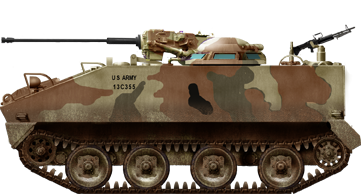
M114A2 of the National Guard.
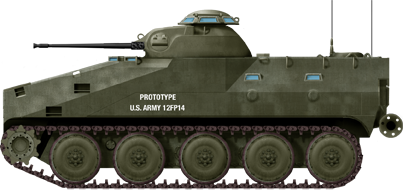
MICV65: XM701
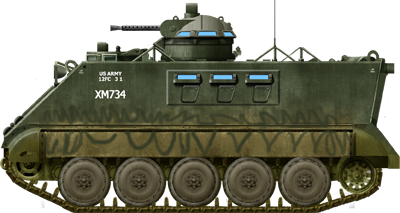
MICV65: XM734
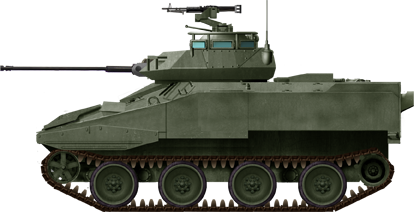
MICV70: XM800
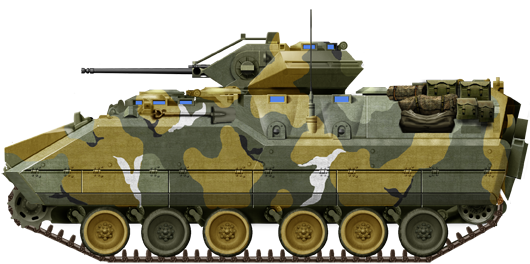
MICV70: XM723
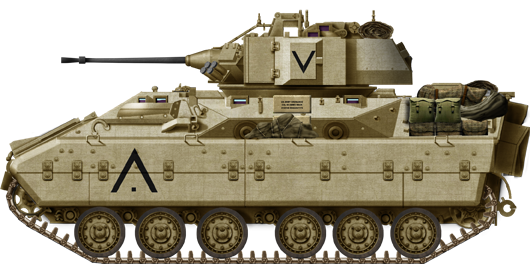
Early M2 Bradley, Operation Reforger 1985.

Early M2 Bradley, other side.

M2 Bradley 2nd Armoured Division, 1st, 41 Infantry.

Early M2 Bradley in MERDC colors, 1982

M2A1 7th Inf. 2nd Brigade 24 Infantry Div (Mechanized) Iraq Feb. 1991

M2A1 197 Infantry Brigade XVII Corps, Op. Desert Shield 1990
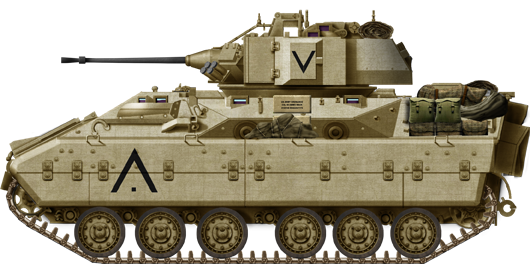
M2A1 Bradley during desert storm, 1991

M2A1 3rd Armoured Division Germany 1990

M2A2 KFOR Bosnia 1995

M2A2 2nd Bat. 7th Inf. Rgt. Mechanized, Iraq 2000s

M2A2 PDS, Iraq 2001

Saudi M2A2

Ukrainian M2A2 Bradley, 2023

M2A2 Bradley of a NATO unit training, 1990s

M2A3 Bradley, European NATO camo

M2A3 Bradley, Afghanistan theater sand pattern
M2A4 Bradley (to come, no operational vehicle so far)
M3 CRV

M3 Bradley 1/12 Cav. Fort Knox 1986

M3A1 HQ Comp. 2/32 Cav. 3th F. Armoured Div. Germany 1989
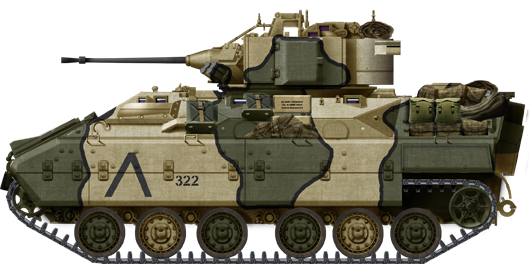
M3 Bradley CRV of a reconnaissance batallion Operation Desert Storm 1991
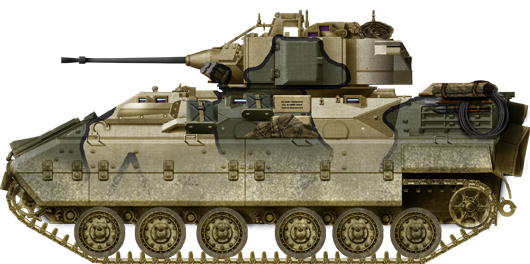
Same under dust.
Photos

M2 interior

M2 exiting the water with flotation skirts at Victory Pond, 1983

1-7 cav M3 Bradley CVFs at CALFEX with Slovakian forces

M2A3 Prepare for Patrol

M2A3

M2A2 with ERA, Somalia, UNOSOM II

Bradley M2A4 adanced running gear trials

M2 Bradley at REFORGER 1985

M2 in conceamed firing

Bradley at Shadow Hawk 1987

Bradley in Saudi Arabia, Operation Desert Shield

Bradley M2A2 and BTR-80 in Bosnia 1995

Bradley gunnery of the Bulldog Brigade

M2A2 in Afghanistan

Same

Same, loading troops

Dark Horse AMPV: This is an interesting replacement for the M113, based on the M2 Bradley, designed by BAE systems and selected in 2014. The Armored Multi-Purpose Vehicle (AMPV) is a sub-project of the Next Generation Combat Vehicle program. Total replacement is at the 2,800 M113A3 mark. Five variants, 2,907 AMPV later were planned, the M1283 General Purpose (522), M1284 Medical Evacuation Vehicle (790), M1285 Medical Treatment Vehicle (216), M1286 Mission Command (993), M1287 Mortar Carrier Vehicle (386) according to 2015 estimates. The first prototype was tested in December 2016, first production model in September 2020. By March 2023, the 1st Armored Brigade Combat Team, 3rd Infantry Division at Fort Stewart, Georgia, tested the first pilots production models. As of 5 August 2023, the AMPV had entered full-rate initial production.[8]

European livery Bradleys A2/A3 launching TOWS
Sources

Books
-The Bradley and How It Got That Way, Technology, Institutions, and the Problem of Mechanized Infantry in the United States Army, W. Blair Haworth, Greenwood Publishing.-Steven J. Zaloga, Peter Sarson M2/M3 Bradley
-Infantry Fighting Vehicle 1983–95 New Vanguard 18 -Bradley: A History of American Fighting and Suport Vehicles - by R P Hunnicutt -U.S. Army Infantry Fighting Vehicles by Martha E Rustad -The M2 Bradley Infantry Fighting Vehicle (Cross-Sections) by Steve Parker
-M2/M3 Bradley at War by James D Brown, Michael Green.
Links
On CopybookOn wikipedia (general frame)
On military-technology
On military-today
About the Bradley 2
Detailed specs
On Military.com
On tanknutdave
BAE System Official Page
On Military Factory
The Bradley on fas.org
Many references
XM701 on russiantanks.com
Pdf Doc about the Bradley Development-
btvtinfo.blogspot.com evol M3 halftrack to bradley
On sturgeonshouse.ipbhost.com
man.fas.org
pogo.org 2003 Bradley
armour.ws
the-u-s-army-wanted-to-replace-the-bradley-38-years-ago
armyrecognition.com
btvt.info
The XM765 on globalmilitary
XM734 on russiantanks.com
M113 later variants (XM 765) on russiantanks.com
nytimes.com corrupt-from-top-to-bottom
oryxspioenkop.com losses in Ukraine
washingtonpost.com/
thedrive.com
youtube.com
en.topwar.ru
Video
Models and variants

Good old Tamiya 1:32 kit
Main query on scalemates

Cold War Tanks


































Cold war tanks posters

Cold War Main Battle Tanks

Cold War Soviet Army
Museums, Movies, Books & Games
The Tanks and Armor in pop culture
Tanks and armored vehicles in general are only really grasped when seen first person: The mass, the scale, it's all there. Explore also the way tanks were covered in the movie industry, in books and in video games.Movies:
Best tanks movie on warhistoryonline.com
On imdb.com
On bestsimilar.com/
miltours.com
liveabout.com/
watchmojo.com
Video Games:
pcgamesn.com
historyhit.com
levvvel.com
vg247.com/best-tank-games
mmobomb.com/
alienwarearena.com

